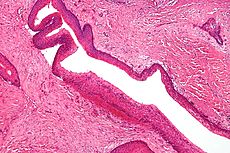- Nevoid basal cell carcinoma syndrome
-
Nevoid basal cell carcinoma syndrome Classification and external resources 
Micrograph showing keratocystic odontogenic tumour, a common finding in nevoid basal cell carcinoma syndrome. H&E stain.OMIM 109400 DiseasesDB 5370 eMedicine derm/291 MeSH C04.182.089.530.690.150 Nevoid basal cell carcinoma syndrome (NBCCS), also known as basal cell nevus syndrome, multiple basal cell carcinoma syndrome, Gorlin syndrome, and Gorlin–Goltz syndrome, is an inherited medical condition involving defects within multiple body systems such as the skin, nervous system, eyes, endocrine system, and bones.[1] People with this syndrome are particularly prone to developing a common and usually non-life-threatening form of non-melanoma skin cancers.
About 10% of people with the condition do not develop basal cell carcinomas (BCCs). the name Gorlin syndrome refers to researcher Robert J. Gorlin (1923–2006).[2]
First described in 1960, NBCCS is an autosomal dominant condition that can cause unusual facial appearances and a predisposition for basal cell carcinoma, a malignant type of skin cancer.[3] The prevalence is reported to be 1 case per 56,000-164,000 population. Recent work in molecular genetics has shown NBCCS to be caused by mutations in the PTCH (Patched) gene found on chromosome arm 9q.[4] If a child inherits the defective gene from either parent, he or she will have the disorder.
Contents
Incidence
About 750,000 new cases of sporadic basal cell carcinomas (BCCs) occur each year in the United States. Ultraviolet (UV) radiation from the sun is the main trigger of these cancers, and people with fair skin are especially at risk. Most sporadic BCCs arise in small numbers on sun-exposed skin of people over age 50, although younger people may also be affected. By comparison, NBCCS has an incidence of 1 in 50,000 to 150,000 with higher incidence in Australia. One aspect of NBCCS is that basal cell carcinomas will occur on areas of the body which are not generally exposed to sunlight, such as the palms and soles of the feet and lesions may develop at the base of palmar and plantar pits. One of the prime features of NBCCS is development of multiple BCCs at an early age, often in the teen years. Each person who has this syndrome is affected to a different degree, some having many more characteristics of the condition than others.
Components
Some or all of the following may be seen in someone with Gorlin Syndrome:
- Multiple basal cell carcinomas of the skin
- Odontogenic keratocyst: Seen in 75% of patients and is the most common finding. There are usually multiple lesions found in the mandible. They occur at a young age (19 yrs average).
- Rib and vertebrae anomalies
- Intracranial calcification
- Skeletal abnormalities: bifid ribs, kyphoscoliosis, early calcification of falx cerebri (diagnosed with AP radiograph)
- Distinct faces: frontal and temporopariental bossing, hypertelorism, and mandibular prognathism
Diagnostic criteria
Diagnosis of NBCCS is made by having 2 major criteria or 1 major and 2 minor criteria. [2]
The major criteria consist of the following:
- more than 2 BCCs or 1 BCC in a person younger than 20 years;
- odontogenic keratocysts of the jaw
- 3 or more palmar or plantar pits
- ectopic calcification or early (<20 years) calcification of the falx cerebri
- bifid, fused, or splayed ribs
- first-degree relative with NBCCS.
The minor criteria include the following:
- macrocephaly.
- congenital malformations, such as cleft lip or palate, frontal bossing, eye anomaly (cataract, colobma, microphtalmia, nystagmus).
- other skeletal abnormalities, such as Sprengel deformity, pectus deformity, polydactyly, syndactyly or hypertelorism.
- radiologic abnormalities, such as bridging of the sella turcica, vertebral anomalies, modeling defects or flame-shaped lucencies of hands and feet.
- ovarian and cardio fibroma or medulloblastoma (the latter is generally found in children below the age of two).
People with NBCCS need education about the syndrome, and may need counseling and support, as coping with the multiple BCCs and multiple surgeries is often difficult. They should reduce UV light exposure, to minimize the risk of BCCs. They should also be advised that receiving Radiation therapy for their skin cancers may be contraindicated. They should look for symptoms referable to other potentially involved systems: the CNS, the genitourinary system, the cardiovascular system, and dentition.
Genetic counseling is advised for prospective parents, since one parent with NBCCS causes a 50% chance that their child will also be affected.
Treatment
Treatment is usually supportive treatment, that is, treatment to reduce any symptoms rather than to cure the condition.
- Enucleation of the odontogenic cysts can help but new lesions, infections and jaw deformity are usually a result.
- The severity of the basal cell carcinoma determines the prognosis for most patients. BCCs rarely cause gross disfigurement, disability or death [3].
- Genetic counseling
See also
References
- ^ Kimonis V, Goldstein A, Pastakia B, Yang M, Kase R, DiGiovanna J, Bale A, Bale S (1997). "Clinical manifestations in 105 persons with nevoid basal cell carcinoma syndrome". Am J Med Genet 69 (3): 299–308. doi:10.1002/(SICI)1096-8628(19970331)69:3<299::AID-AJMG16>3.0.CO;2-M. PMID 9096761.
- ^ [1] Robert W. Goltz was his co-worker.
- ^ Gorlin R, Goltz R (1960). "Multiple nevoid basal-cell epithelioma, jaw cysts and bifid rib. A syndrome". N Engl J Med 262 (18): 908–12. doi:10.1056/NEJM196005052621803. PMID 13851319.
- ^ Johnson R, Rothman A, Xie J, Goodrich L, Bare J, Bonifas J, Quinn A, Myers R, Cox D, Epstein E, Scott M (1996). "Human homolog of patched, a candidate gene for the basal cell nevus syndrome". Science 272 (5268): 1668–71. doi:10.1126/science.272.5268.1668. PMID 8658145.
External Links
- GeneReviews/NCBI/NIH/UW entry on Nevoid Basal Cell Carcinoma Syndrome
- GeneReviews/NCBI/NIH/UW entry on 9q22.3 Microdeletion
- US National Library of Medicine page
Categories:- Cell surface receptor deficiencies
- Epidermal nevi, neoplasms, cysts
Wikimedia Foundation. 2010.
